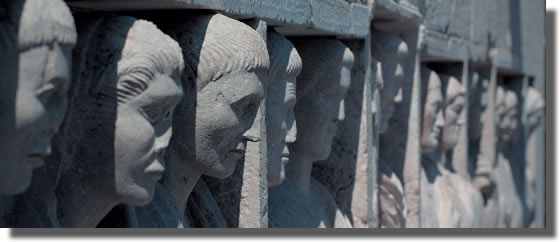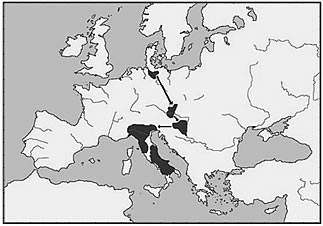Scientific Area » Longobard Culture » The Long Transition
« Back
THE LONG TRANSITION (4th/5th - 8th century)
The most recent storiographic debate has led to a profound renewal of studies on the transition age between the classic and the medieval world (4th/5th – 8thcentury).
The age between the collapse of the Roman Empire and the rise of the Carolingian Empire has been re-valued for subsequent developments of the European civilization: in contrast to the notions of “decadence”, “end” of the civilization and “barbarism”, the idea is currently being devised of a continuum of a historical process characterized by the interpenetration of different civilizations.
This theory denies radical changes and needs to be evaluated also in the light of archaeological discoveries as well as direct physical evidence which allow to “filter” and “read again” the history handed down by written texts.

Historical assumptions which regarded the Barbarian settlement in the provinces surrounding the Western Roman Empire as the beginning of a point-of- no-return crisis for the Roman institutions - with all the consequences in terms of management, administration, institutions, public services and structure of the empire - are being disproved today by a different vision already proposed in storiography in the second half of 19th century. It redefined the long transformation process which preceded the Germanic dominations in the West by identifying a number of factors which determined it including:
- the economic and productive crises of 3rd-4th century
- the inarrestable mingling process concerning peoples and cultures – mainly due to the increasing presence of barbarian foederati in the Roman Imperial troops -
- a clearer impact of Middle Eastern customs and traditions on the Roman Mediterranean culture, regionalistic crises resulted in social uprisings in Gaul, Armorica, Spain and Britannia (the bagaudae of 3rd-4th century),
- the different interpretations of Christianity which led to heresies like Donatism, Nestorianism and Aryanism - spread in northern Africa, the Middle East, north-eastern Europe – which generated a sort of religious and social regionalization.
In brief it is now being recognised that the rupture occurred in 6th century was just the apex of a process of both social and cultural disintegration but also of generalized interculturalism, whose origin is to be traced back to previous centuries.
Basically, the crisis of the Western Roman Empire and its cultural system, caused by the introduction of barbarians into Romance Europe (Romània), assumed at first the shape of a clash and later of a progressive meeting, with cultural and institutional repercussions, which enables us to regard the timeframe between 4th and 8th century as a long dynamic historical cultural transition which generated the European civilization rather than a decay of classical culture.
The issues raised by the debate between archaeologists and historians as well as the numerous archaeological discoveries therefore concern complex and diverse problems ranging from the abandonment of countryside, through the end of villas (5th-6th century), to the progressive breakdown of the urban fabric of great cities, through the reuse of buildings, public spaces and materials, significantly exemplified in the Pavia case by Ennodius (4th century) who described densely populated hovels made out of Roman public buildings during the invasion of the Rugii “…domarum immanium culmina in augustissimis resecata tuguriis…”.

In the Longobard period such aspect was a distinguishing mark of all Italy with no exception of Byzantine cities like Rome, Ravenna, Rimini etc.
The reuse and privatization of public spaces, the building of houses using poor and perishable materials located in noble areas such as Campo Marzio in Rome, were widespread throughout the Italian peninsula and on the other side of the Alps (e.g. Verona, Brescia, Ravenna, Lyons, Paris, Arles, Angers) also despite wars, which urged banning rules under Emperor Theodosius (397) and Zeno (483) (CTh.14.14.1, Codex VIII, 10; de Aed. Priv. 12.5). Such rules were incorporated into the Codex Iustinianus with a view to protecting the ancient appearance of such cities as Rome.
« Back


